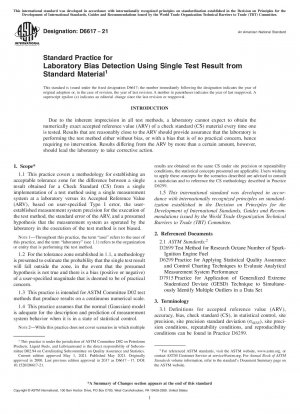ASTM D6617-21
Standard Practice for Laboratory Bias Detection Using Single Test Result from Standard Material
- Standard No.
- ASTM D6617-21
- Release Date
- 2021
- Published By
- American Society for Testing and Materials (ASTM)
- Latest
- ASTM D6617-21
- Scope
- 1.1 This practice covers a methodology for establishing an acceptable tolerance zone for the difference between a single result obtained for a Check Standard (CS) from a single implementation of a test method using a single measurement system at a laboratory versus its Accepted Reference Value (ARV), based on user-specified Type I error, the userestablished measurement system precision for the execution of the test method, the standard error of the ARV, and a presumed hypothesis that the measurement system as operated by the laboratory in the execution of the test method is not biased. NOTE 1—Throughout this practice, the term “user” refers to the user of this practice, and the term “laboratory” (see 1.1) refers to the organization or entity that is performing the test method. 1.2 For the tolerance zone established in 1.1, a methodology is presented to estimate the probability that the single test result will fall outside the zone, in the event that the presumed hypothesis is not true and there is a bias (positive or negative) of a user-specified magnitude that is deemed to be of practical concern. 1.3 This practice is intended for ASTM Committee D02 test methods that produce results on a continuous numerical scale. 1.4 This practice assumes that the normal (Gaussian) model is adequate for the description and prediction of measurement system behavior when it is in a state of statistical control. NOTE 2—While this practice does not cover scenarios in which multiple results are obtained on the same CS under site precision or repeatability conditions, the statistical concepts presented are applicable. Users wishing to apply these concepts for the scenarios described are advised to consult a statistician and to reference the CS methodology described in Practice D6299. 1.5 This international standard was developed in accordance with internationally recognized principles on standardization established in the Decision on Principles for the Development of International Standards, Guides and Recommendations issued by the World Trade Organization Technical Barriers to Trade (TBT) Committee.
ASTM D6617-21 Referenced Document
- ASTM D2699 Standard Test Method for Research Octane Number of Spark-Ignition Engine Fuel
- ASTM D6299 Standard Practice for Applying Statistical Quality Assurance and Control Charting Techniques to Evaluate Analytical Measurement System Performance*, 2023-07-01 Update
- ASTM D7915 Standard Practice for Application of Generalized Extreme Studentized Deviate (GESD) Technique to Simultaneously Identify Multiple Outliers in a Data Set*, 2022-05-01 Update
ASTM D6617-21 history
- 2021 ASTM D6617-21 Standard Practice for Laboratory Bias Detection Using Single Test Result from Standard Material
- 2017 ASTM D6617-17 Standard Practice for Laboratory Bias Detection Using Single Test Result from Standard Material
- 2013 ASTM D6617-13 Standard Practice for Laboratory Bias Detection Using Single Test Result from Standard Material
- 2008 ASTM D6617-08 Standard Practice for Laboratory Bias Detection Using Single Test Result from Standard Material
- 2005 ASTM D6617-05 Standard Practice for Laboratory Bias Detection Using Single Test Result from Standard Material
- 2000 ASTM D6617-00 Standard Practice for Laboratory Bias Detection Using Single Test Result from Standard Material
